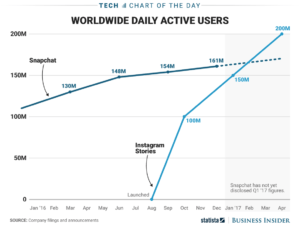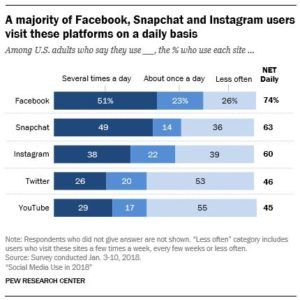Instagram – The Unstoppable Value-Creation Machine

Instagram has emerged as
#Value-Creation #Value-Capture #Product-Platform #Social-Media
Instagram started as a photo-sharing product that helped users enhance (initially though the use of filters) and share their photos with other users. Nevertheless, today it is a multi-faceted platform, with multiple products and distinct groups of users.
A Promising Product (2011-2012)
Instagram was initially focused on growing a critical mass of users, by working on its product and improving it with features such as hashtags for photo discovery, improved filters, etc. Instagram eventually reached 10 million users in a year and 40 million users in just under a year and a half [1]. This is when Facebook came knocking on Instagram’s door and acquired it for $1 billion[2]. Back then, Instagram was still a product business with no revenue[3]. Instagram’s growth was partly attributable to an attractive product but also its ability to benefit from same-side network effects, as more users joined, the value of the network and product increased. It can be argued that it is post-Facebook acquisition that Instagram evolved into a Hybrid business model of Product/Platform. Nevertheless, early signs of shifts to a platform were noticeable as a new group of users was emerging on Instagram: the influencers[4]. The influencers leveraged their high number of followers to attract marketing placements and get paid for it. This is pure value creation and extraction on top of the Instagram platform.
From Product to a Hybrid Product-Platform (2013-2016)
Instagram kept differentiating its product with additional value-creating features such as Instagram Video in 2013 (it started with 15 seconds videos and went to 60 seconds in 2016), Instagram Direct in 2013 (private messaging between users) and Instagram Stories in 2016 (Snapchat-like photos/videos that unlike Snapchat don’t disappear). However, as Instagram was building its product strategy to continue attracting users (reaching 600 million users in 2016)[5] and keeping them engaged, it also looked at making Instagram a legitimate platform that can generate multiple revenue streams i.e. capturing value. It started with attracting businesses through ads; first through Facebook in 2013[6] and then directly on its platform in 2015[7]. In order to attract businesses and generate ad-revenue, Instagram had not only to create value for advertisers through their ‘sponsored’ ads but also be able to communicate the value creation through full-fledged metrics such as reach, ad recall and awareness[8] and its ability to leverage data collected either through its platform or Facebook to target users more accurately and effectively[9]. The wave of Instagram influencers and the indirect ad placements done through them only added credibility to Instagram’s power as an advertising/marketing platform. Furthermore, the introduction of Instagram business in 2016[10] upped the possibility of revenue-generation and potential for Instagram to capture even more value. Instagram for business offer businesses even more insights through data, creating value for businesses as it shares with them the value it creates by monitoring its users.
Instagram today (2017-2018)
Instagram’s focus is now on daily active users as it reached 500 million (Monthly Active Users of 800 million). This focus on customer engagement enables Instagram not only to attract over 2 million advertisers[11] but also to take advantage of the network effect in building a sticky platform for users. The network effects are no longer only same-sided but also cross-sided as advertisers, businesses and influencers all benefit from additional individual(non-commercial) users on the platform.
Instagram big jump in Daily Active Users, mainly attributed to the introduction of Instagram Story (a Snapchat knock-off)[please see figure 1], may point to a winner takes most-market as multi-homing is still very present [figure 2] but it can be argued that it gets weakened over time as Instagram (along with Facebook) builds a platform with multiple product offerings (one-stop-shop). There is also data that points to different platforms attracting different user segments e.g. Snapchat being more popular with 18-24 year old users and Instagram/Facebook with 25+ years old users[12].
As Instagram continues to work on its product and platform by creating value for its non-commercial users, increasing their engagement, it enables its commercial users (businesses, advertisers and influencers) to capture some of the value generated and sharing it with Instagram. Instagram does the same with data as it captures value that it shares with businesses, expecting revenue and engagement in return. Other than advertising revenue through sponsored posts/ads (including Carousel ads and video ads on Instagram Stories), Instagram leveraged its platform with non-ad revenue through selling filters, providing data but now also through taking the platform to the next level with its Shopping feature.[13] This shopping feature enables to create more value for businesses and users by making it easier to shop directly on Instagram, but also capture some of it through adding a novel revenue stream. Instagram keeps surprising us the ways that it takes advantage of its hybrid product-platform to create a machine that seems unstoppable.
Figure 1:
Figure 2:
[1] https://techcrunch.com/2012/04/13/instagrams-user-count-now-at-40-million-saw-10-million-new-users-in-last-10-days/
[2] https://techcrunch.com/2012/04/09/facebook-to-acquire-instagram-for-1-billion/
[3] http://money.cnn.com/2012/04/09/technology/facebook_acquires_instagram/
[4] http://www.adweek.com/brand-marketing/instagrammers-demand-major-brands-140792/
[5] http://www.businessinsider.com/instagram-hits-600-million-users-2016-12
[6] https://techcrunch.com/2013/10/24/first-look-at-instagram-ads/
[7] https://www.nytimes.com/2015/06/03/technology/instagram-to-announce-plans-to-expand-advertising.html
[8] https://www.forbes.com/sites/roberthof/2013/12/19/instagram-says-its-brand-advertising-campaigns-are-working/#77b01d9613f3
[9] https://business-reporter.co.uk/2015/08/10/instagram-leverages-facebook-data-for-targeted-advertising/
[10] https://techcrunch.com/2016/05/31/instagram-officially-announces-its-new-business-tools/
[11] https://techcrunch.com/2017/09/25/instagram-now-has-800-million-monthly-and-500-million-daily-active-users/
[12] http://www.adweek.com/digital/the-18-through-24-age-group-continues-to-be-drawn-to-snapchat-and-instagram/
[13] https://www.theverge.com/2017/10/5/16418776/instagram-shopify-shopping





Thank you for the post, MAB! I enjoyed the way you presented the evolution of Instagram from a not yet monetized product to the cross-sided network effect platform it is today. I think that Instagram has done a great job riding the mobile device oriented wave and adapting its advertising monetization strategy accordingly. With the introduction of carousel ads, vertical video ads, and direct response ads, Instagram has been able to offer a wide variety of creative ways for advertisers to reach out to target customers utilizing the platform. I would be very curious to hear your opinion concerning a winner take all or winner take most market in this space. Will Facebook and Google continue to duopolize mobile ad spending or will players like Snap be able to make and maintain some share?
Thank you Mike! In theory, I do believe that it could be a winner takes all market; but I believe that there could be enough room/opportunity for differentiation here (i.e. the value proposition is not commoditized), and that means we are more likely to end in a winner takes most market (and not takes all). What do you think?